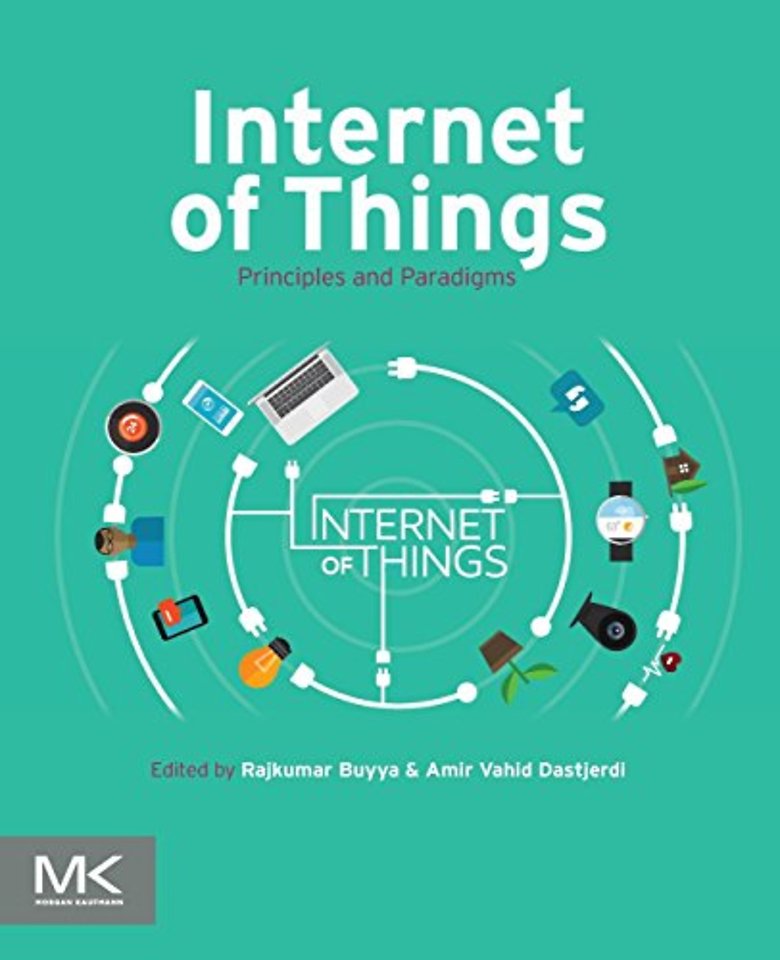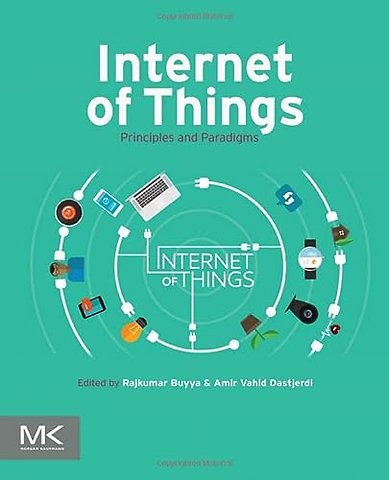


Dr. Rajkumar Buyya is a Fellow of IEEE, Professor of Computer Science and Software Engineering, Future Fellow of the Australian Research Council, and Director of the Cloud Computing and Distributed Systems (CLOUDS) Laboratory at the University of Melbourne, Australia.
Meer over de auteursInternet of Things
Principles and Paradigms
Samenvatting
Key Feature:
- Addresses the main concepts and features of the IoT paradigm
- Describes different architectures for managing IoT platforms
- Provides insight on trust, security, and privacy in IoT environments
- Describes data management techniques applied to the IoT environment
- Examines the key enablers and solutions to enable practical IoT systems
- Looks at the key developments that support next generation IoT platforms
- Includes input from expert contributors from both academia and industry on building and deploying IoT platforms and applications
'Internet of Things: Principles and Paradigms' captures the state-of-the-art research in Internet of Things, its applications, architectures, and technologies. The book identifies potential future directions and technologies that facilitate insight into numerous scientific, business, and consumer applications. The Internet of Things (IoT) paradigm promises to make any electronic devices part of the Internet environment. This new paradigm opens the doors to new innovations and interactions between people and things that will enhance the quality of life and utilization of scarce resources.
To help realize the full potential of IoT, the book addresses its numerous challenges and develops the conceptual and technological solutions for tackling them. These challenges include the development of scalable architecture, moving from closed systems to open systems, designing interaction protocols, autonomic management, and the privacy and ethical issues around data sensing, storage, and processing.
Graduate level Computer Science students studying IoT, sensors network, distributed systems, networks security, cloud computing, and Big Data. IoT practitioners, including network architects, data scientists, computer engineers, and IoT and cloud developers.
Specificaties
Over Amir Vahid Dastjerdi
Inhoudsopgave
About the Editors
Preface
Acknowledgments
Part I: IoT ecosystem concepts and architectures
1. Internet of Things: an overview
Abstract
1.1. Introduction
1.2. Internet of Things definition evolution
1.3. IoT architectures
1.4. Resource management
1.5. IoT data management and analytics
1.6. Communication protocols
1.7. Internet of Things applications
1.8. Security
1.9. Identity management and authentication
1.10. Privacy
1.11. Standardization and regulatory limitations
1.12. Conclusions
2. Open source semantic web infrastructure for managing IoT resources in the Cloud
Abstract
2.1. Introduction
2.2. Background/related work
2.3. OpenIoT architecture for IoT/cloud convergence
2.4. Scheduling process and IoT services lifecycle
2.5. Scheduling and resource management
2.6. Validating applications and use cases
2.7. Future research directions
2.8. Conclusions
Acknowledgments
3. Device/Cloud collaboration framework for intelligence applications
Abstract
3.1. Introduction
3.2. Background and related work
3.3. Device/cloud collaboration framework
3.4. Applications of device/cloud collaboration
3.5. Future work
3.6. Conclusions
Acknowledgments
4. Fog Computing: principles, architectures, and applications
Abstract
4.1. Introduction
4.2. Motivating scenario
4.3. Definitions and characteristics
4.4. Reference architecture
4.5. Applications
4.6. Research directions and enablers
4.7. Commercial products
4.8. Case study
4.9. Conclusions
Part II: IoT enablers and solutions
5. Programming frameworks for Internet of Things
Abstract
5.1. Introduction
5.2. Background
5.3. Survey of IoT programming frameworks
5.4. Future research directions
5.5. Conclusions
6. Virtualization on embedded boards as enabling technology for the Cloud of Things
Abstract
6.1. Introduction
6.2. Background
6.3. Virtualization and real-time
6.4. Experimental results
6.5. Future research directions
6.6. Conclusions
7. Micro Virtual Machines (MicroVMs) for Cloud-assisted Cyber-Physical Systems (CPS)
Abstract
7.1. Introduction
7.2. Related work
7.3. Architecture for deploying CPS in the Cloud and the expansion of the IoT
7.4. Extending the possibilities of the IoT by Cloud Computing
7.5. Micro Virtual Machines with the Sensor Observation Service, the path between smart objects and CPS
7.6. IoT architecture for selected use cases
7.7. Future research directions
7.8. Conclusions
Part III: IoT data and knowledge management
8. Stream processing in IoT: foundations, state-of-the-art, and future directions
Abstract
8.1. Introduction
8.2. The foundations of stream processing in IoT
8.3. Continuous Logic Processing System
8.4. Challenges and future directions
8.5. Conclusions
9. A framework for distributed data analysis for IoT
Abstract
9.1. Introduction
9.2. Preliminaries
9.3. Anomaly detection
9.4. Problem statement and definitions
9.5. Distributed anomaly detection
9.6. Efficient incremental local modeling
9.7. Summary
Part IV: IoT reliability, security, and privacy
10. Security and privacy in the Internet of Things
Abstract
10.1. Concepts
10.2. IoT security overview
10.3. Security frameworks for IoT
10.4. Privacy in IoT networks
10.5. Summary and conclusions
11. Internet of Things—robustness and reliability
Abstract
11.1. Introduction
11.2. IoT characteristics and reliability issues
11.3. Addressing reliability
12. Governing Internet of Things: issues, approaches, and new paradigms
Abstract
12.1. Introduction
12.2. Background and related work
12.3. IoT governance
12.4. Future research directions
12.5. Conclusions
13. TinyTO: two-way authentication for constrained devices in the Internet of Things
Abstract
13.1. Introduction
13.2. Security aspects and solutions
13.3. Design decisions
13.4. TinyTO protocol
13.5. Evaluation
13.6. Summary
Acknowledgments
14. Obfuscation and diversification for securing the internet of things (IoT)
Abstract
14.1. Introduction
14.2. Distinguishing characteristics of IoT
14.3. Obfuscation and diversification techniques
14.4. Enhancing the security in IoT using obfuscation and diversification techniques
14.5. Different use-case scenarios on software diversification and obfuscation
14.6. Conclusions and future work
Part V: IoT applications
15. Applied Internet of Things
Abstract
15.1. Introduction
15.2. Scenario
15.3. Architecture overview
15.4. Sensors
15.5. The gateway
15.6. Data transmission
15.7. Conclusions
Acknowledgments
16. Internet of Vehicles and applications
Abstract
16.1. Basics of IoV
16.2. Characteristics and challenges
16.3. Enabling technologies
16.4. Applications
16.5. Summary and future directions
17. Cloud-Based Smart-Facilities Management
Abstract
17.1. Introduction
17.2. Background and related work
17.3. A cloud-based architecture for smart-facility management
17.4. Middleware services
17.5. Resource management techniques for wireless sensor networks
17.6. Resource management techniques for supporting data analytics
17.7. Case study: management of sensor-based bridges
17.8. Case study: research collaboration platform for management of smart machinery
17.9. Conclusions
Acknowledgments
Index











